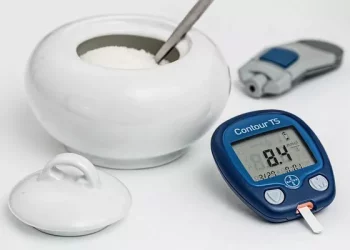Managing blood sugar levels is a cornerstone of diabetes care. Whether you are newly diagnosed with diabetes or have been living with the condition for years, understanding the target blood sugar levels is essential for your health. Maintaining these levels within an acceptable range helps prevent complications and ensures optimal health. For people with diabetes, keeping track of blood sugar is not just about avoiding high blood sugar (hyperglycemia) but also preventing low blood sugar (hypoglycemia), both of which can have serious consequences. This article offers a comprehensive guide to the acceptable blood sugar levels for diabetics, explaining the importance of monitoring, the factors that influence these levels, and how to manage blood sugar effectively to stay within the desired range.
Blood Sugar and Diabetes: A Brief Overview
Blood sugar, also known as blood glucose, is the primary source of energy for the body’s cells. The pancreas, an organ located near the stomach, produces a hormone called insulin. Insulin helps the body absorb glucose from the bloodstream into the cells, where it is used for energy. In individuals with diabetes, this process is disrupted.
Type 1 diabetes is an autoimmune condition where the immune system attacks and destroys the insulin-producing cells in the pancreas. People with type 1 diabetes require lifelong insulin therapy to manage their blood sugar levels.
Type 2 diabetes, which is more common, occurs when the body becomes resistant to insulin or when the pancreas can no longer produce enough insulin to maintain normal blood sugar levels. It is often associated with obesity, poor diet, lack of physical activity, and genetics.
Gestational diabetes is a form of diabetes that can develop during pregnancy, characterized by high blood sugar that usually resolves after childbirth.
Regardless of the type of diabetes, it is crucial for people with diabetes to monitor their blood sugar levels regularly to keep them within a target range. If blood sugar levels are too high or too low, it can lead to short- and long-term complications.
Understanding Blood Sugar Levels: What Is Normal?
For individuals without diabetes, the body maintains blood glucose levels within a narrow range. The American Diabetes Association (ADA) provides the following guidelines for normal blood sugar levels:
Fasting blood sugar (before meals): 70–99 mg/dL
Postprandial (after meal) blood sugar: Less than 140 mg/dL
Hemoglobin A1c (average blood sugar over 2-3 months): Less than 5.7%
For diabetics, the target blood sugar range may vary depending on factors like age, overall health, treatment plan, and whether they have other conditions. The ADA provides general recommendations for people with diabetes:
Fasting blood sugar: 80–130 mg/dL
Postprandial blood sugar (2 hours after meals): Less than 180 mg/dL
A1c: Below 7%, though some individuals may have slightly higher or lower targets based on individual circumstances and the advice of their healthcare provider.
These targets are intended to reduce the risk of diabetes-related complications, including cardiovascular disease, kidney damage, and nerve damage, while also minimizing the risk of hypoglycemia (low blood sugar).
What Factors Influence Blood Sugar Levels in Diabetics?
Several factors can affect blood sugar levels, and understanding these can help diabetics make informed decisions about how to manage their condition. These factors include:
Dietary Habits: What you eat plays a significant role in blood sugar control. Carbohydrates, in particular, have the most direct impact on blood sugar. Foods like bread, pasta, rice, and sugary snacks can cause a rapid increase in blood glucose levels. The glycemic index (GI) of a food is an important consideration, as foods with a high GI cause a faster and higher spike in blood sugar levels.
Physical Activity: Exercise helps the body use glucose more effectively and can help lower blood sugar levels. Aerobic exercise, such as walking, jogging, or swimming, increases insulin sensitivity, while strength training can build muscle, which also helps improve blood sugar control.
Medications: People with diabetes often take medications or insulin to help control blood sugar. The dosage and timing of medications, as well as the type of insulin used, can have a significant impact on blood sugar levels.
Stress: Stress can trigger the release of stress hormones, such as cortisol and adrenaline, which can increase blood sugar levels. Chronic stress may contribute to sustained high blood glucose levels.
Illness or Infection: When the body is sick or under stress due to an infection, blood sugar levels can rise. During illness, the body releases hormones like cortisol and adrenaline, which can reduce the effectiveness of insulin.
Hormonal Changes: Hormones, particularly during pregnancy (gestational diabetes), menstruation, or menopause, can influence blood sugar regulation. For example, women with diabetes may notice changes in their blood glucose levels related to the menstrual cycle.
Sleep: Poor sleep or sleep disturbances can lead to higher blood sugar levels. This is often because lack of sleep can increase insulin resistance, making it harder for the body to regulate blood glucose.
Why Is It Important to Maintain Acceptable Blood Sugar Levels?
Maintaining acceptable blood sugar levels is essential for several reasons, both for short-term well-being and long-term health. When blood sugar levels are consistently outside the recommended range, it can lead to various health problems.
Preventing Hyperglycemia (High Blood Sugar):
Chronic high blood sugar (hyperglycemia) can cause complications like diabetic ketoacidosis (DKA) in type 1 diabetes or hyperosmolar hyperglycemic state (HHS) in type 2 diabetes. Both of these conditions can be life-threatening if not addressed promptly.
Prolonged hyperglycemia damages the blood vessels and nerves, increasing the risk of cardiovascular disease, kidney disease, and neuropathy.
Preventing Hypoglycemia (Low Blood Sugar):
Blood sugar that falls too low (below 70 mg/dL) can lead to hypoglycemia. Symptoms of hypoglycemia include shakiness, confusion, dizziness, sweating, and, in severe cases, loss of consciousness or seizures. Hypoglycemia is typically caused by taking too much insulin or other diabetes medications, skipping meals, or exercising intensely without adjusting medication.
Long-Term Health Benefits:
Maintaining good blood sugar control helps reduce the risk of developing diabetes-related complications, including eye damage (diabetic retinopathy), kidney failure (diabetic nephropathy), and nerve damage (diabetic neuropathy). Additionally, optimal blood glucose levels contribute to overall cardiovascular health, reducing the risk of heart disease and stroke.
Quality of Life:
By keeping blood sugar levels within the target range, people with diabetes can feel better on a day-to-day basis, avoiding the fatigue, blurry vision, and other symptoms of poorly controlled diabetes. Consistent monitoring and control can also prevent mood swings and mental fog associated with fluctuating glucose levels.
How Can Diabetics Achieve and Maintain Acceptable Blood Sugar Levels?
Achieving and maintaining acceptable blood sugar levels requires a combination of lifestyle modifications, medication management, and regular monitoring. Below are several strategies that diabetics can use to maintain their blood glucose within the recommended range.
Consistent Blood Sugar Monitoring:
Regularly checking blood sugar levels is crucial for understanding how food, exercise, stress, and medications affect glucose levels. Diabetics can use home glucose meters or continuous glucose monitors (CGMs) to track their levels throughout the day. The frequency of monitoring depends on the type of diabetes and the treatment regimen, but it is generally recommended to check levels before meals and at bedtime.
Adhering to a Healthy Diet:
Carbohydrate counting: People with diabetes should learn how to count carbohydrates to better manage their blood sugar. Understanding the carb content of foods and how different types of carbohydrates affect blood glucose is key.
Choosing low-GI foods: Foods that are low on the glycemic index, such as whole grains, legumes, non-starchy vegetables, and lean proteins, are less likely to cause rapid increases in blood sugar.
Balanced meals: Combining carbohydrates with proteins and healthy fats can help stabilize blood sugar levels and prevent sudden spikes or drops.
Regular Physical Activity:
Engaging in regular exercise is one of the most effective ways to improve insulin sensitivity and blood sugar control. Exercise helps the body utilize glucose more efficiently. The American Diabetes Association recommends at least 150 minutes of moderate-intensity aerobic activity per week, along with muscle-strengthening exercises.
Medication Management:
Diabetic medications, including oral medications and insulin, are essential tools for controlling blood sugar. Diabetics should work closely with their healthcare provider to adjust medication dosages based on their blood glucose levels, diet, activity level, and other factors.
Stress Management:
Managing stress is critical for blood sugar control. Techniques such as meditation, deep breathing exercises, yoga, and mindfulness can help reduce stress and minimize its impact on blood sugar.
Get Enough Sleep:
Quality sleep is important for regulating blood glucose levels. Aiming for 7-9 hours of sleep per night and maintaining a consistent sleep schedule can help improve insulin sensitivity and overall health.
Education and Support:
Diabetes education plays a significant role in managing the condition effectively. Diabetics should stay informed about their condition and work with healthcare professionals to develop a personalized plan for managing their blood sugar.
Conclusion
For people with diabetes, understanding and maintaining acceptable blood sugar levels is crucial for both short-term and long-term health. By aiming for blood glucose levels within the recommended range, individuals with diabetes can prevent complications and improve their quality of life. The key to achieving this goal lies in consistent monitoring, making informed dietary and lifestyle choices, and working closely with healthcare providers to adjust treatment plans as needed.
Managing diabetes is not a one-size-fits-all process, and each person’s target blood sugar levels may vary based on their unique health needs. It is important to develop a personalized approach that works for your specific situation and to regularly review your blood glucose management strategies with a healthcare provider.
Related topics:
When Should Diabetics Check Blood Sugar?






















